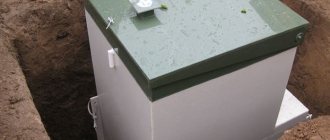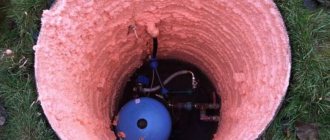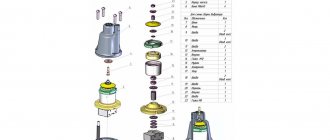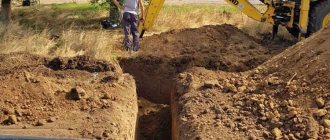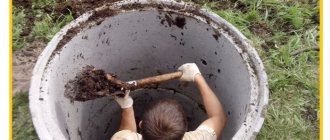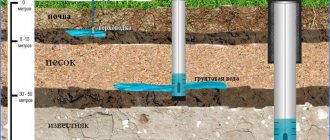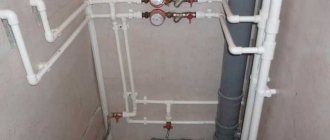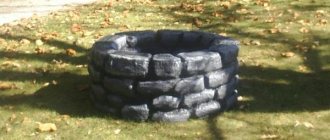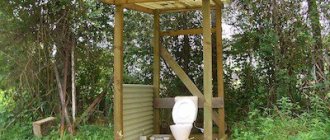Do-it-yourself Abyssinian well from A to Z A
do-it-yourself Abyssinian well can be an excellent solution for organizing water supply in a country house or in a private house. This type of well is a self-contained well of lighter construction. Its depth does not exceed the upper aquifers. In another way, this well is called a well.
Construction of an Abyssinian type well. The Abyssinian well was developed in England in the 19th century to provide water to the colonial army located in Asia and Africa.
What it is?
This is a compact source that allows you to provide water to a country house with a minimum budget and effort. To manufacture it, there is no need to rent large special equipment. Plus, the Abyssinian water well will provide you with the necessary volume all year round.
Let's consider the reasons for its manufacture:
- You will be able to receive water from a shallow depth (up to 20 m).
- The device is placed in a relatively small area.
- It is possible to drill in a garage, inside a residential building and similar premises.
- Financial investments are minimal.
Abyssinian wells and site features
Much depends on the individual characteristics of the site. So that your efforts and money are not wasted, and the Abyssian well does not remain a useless monument to your carelessness, a number of points should be clarified before constructing it yourself:
- The depth of the aquifer. To do this, you can ask your neighbors about the water level in their wells, and also measure the distance to the water surface. If the depth of the wells does not exceed 12-15 m, and the distance to the water surface is no more than 5-10 meters, then there is a high probability that the “needle” will be able to provide the house with water;
- Estimated water quality. The Abyssinian is a shallow well, and this aquifer may be susceptible to bacterial and chemical contamination. Therefore, it is necessary to find out in advance where septic tanks and sewage pits are located, and whether there are sources of chemical pollution nearby. Sometimes, already at this stage, it is necessary to abandon the construction of a well;
- Proposed location for the “needle” device. It can be installed right in the house, in the technical room, then the pumping station and other equipment will be protected from adverse weather conditions, and the well itself from freezing in winter (if the house has permanent residence). If the well is supposed to be installed on the site, then it is better to locate it close to the house. In this case, to bring water into the house, you will have to manually dig a trench under the main line, installing a caisson or an insulated shelter, which leads to additional expenses;
- Estimated needle debit. It largely depends on the saturation of the aquifer. An indirect sign can be the water level in neighboring wells. You should also find out whether they dry out in the summer.
A good water-bearing formation under the “igloo” is located in a vein with coarse (river) sand.
Nedrabur member FORUMHOUSE
The most advanced design of an Abyssinian well will not save you if the aquifer has poor water yield and low thickness.
If the water yield of the Abyssinian is low, you will have to purchase and install a storage tank for water of 500-1000 liters.
The water yield of an already installed well can be found out this way: we note the time of filling the measuring container and see how long it takes to fill a 10-liter bucket. Without stopping pumping, we repeat the procedure 2-3 more times in 10-15 minutes, and we get the average value - the specific flow rate of the well.
Advantages and disadvantages
In the case of high productivity, a needle well has some pros and cons. Among the disadvantages are:
- Depth restrictions. If the distance is more than 9 m, the pump will have to be deepened, and this is a labor-intensive and complex process.
- If it is not used for a long time, the well or well will need cleaning. Leveling up an Abyssinian is a very labor-intensive task. The reason for this is the small diameter of the pipe.
Positive sides:
- Drilling occurs with minimal labor costs.
- The supplied liquid is 90% potable. You don't have to install a complex filtration system.
- Ease of producing needle wells at home or in the country.
- A minimum set of equipment that does not require special equipment for its transportation.
- Possibility of installation in car washes, since the well flow rate is up to 500 l/hour. Productivity – up to 60 l/hour.
- There is no need to pay for expensive specialist services.
- There is no need to obtain a drilling license.
- Minimum cost for the entire installation.
- Long service life.
Abyssinian well - the advantages of a miracle well
The technology for drilling such wells was first used by the Americans in the 19th century. And it received worldwide recognition after the British military operation on the territory of Ethiopia (the old name was Abyssinia). The Abyssinian well has a lot of advantages. Among them, we highlight the key advantages of its use today:
- Low cost of arrangement and the ability to do the work yourself (no need to use any special equipment or invite specialists).
- High quality of the resulting water. It has been proven that even near large domestic cities, the Abyssinian well produces an excellent product. The water from it is in no way inferior to artesian water in most respects. And the absence of a casing pipe ensures that flood and melt waters do not enter the water intake of the Abyssinian well.
- The service life depends solely on the water saturation of the formation in the summer cottage. On average, the needle (as the Abyssinian well is often called) is operated without repairs for about 30 years.
- The possibility of arranging a structure to obtain clean water directly in the cellar of a residential building. This way, the costs of building a well are reduced, because you do not need to additionally insulate it and make a pit.
Abyssinian well - make a miracle well
And most importantly, owners of suburban areas do not need to obtain any licenses or permits to build and operate a well for their summer cottage. You can build an artesian well with your own hands (provided that its depth is no more than 5 m) from metal or plastic pipes.
Operating principle and device
Abyssinian is made from a pipe no larger than 1º, with a depth of up to 30 m. At the bottom of the pipe there is a filter consisting of a mesh of small cells and perforations. The pump is mounted at the top.
To drill a hole, small equipment is used, 1.5 × 1.5 m wide and up to 2.5 m high. To lift the liquid, it is recommended to use a self-priming pump, which is connected directly to the needle. A vacuum is created and the water rises. The water quality is 90% high as it has natural filtration through gravel and sand.
Interesting to know : drilling an Abyssinian well allows you to obtain a liquid with a favorable mineral composition. It contains no metals, salts or other compounds harmful to the body.
Preparing the necessary materials
The design of an Abyssinian well is extremely simple and consists of a set of metal pipes 1-2 m long, connected to each other using couplings, a filter pipe at the bottom for water intake and a pump on the ground surface.
Construction of the Abyssinian well
Step 1. Pipes are preferably galvanized or stainless steel to protect against corrosion, pipe diameter is 1-1½ inches (approximately 2.5-3.8 cm). Copper pipes are not suitable due to the softness of the metal, and copper can release free ions to water, poisoning it. On pipes, except for the lowest one, external threads are cut on both sides.
You may be interested in information on how to connect a pump to a well in your country house
Pipe kit
Step 2. Perforation is performed in the lower pipe, which is a water intake with a filter. The length of the perforated part is 700-1000 mm. The diameter of the holes is 8-10 mm, the center-to-center distance between the holes is 50 mm. The holes are arranged in a checkerboard pattern. Stainless wire is wound over the perforated part according to the diagram.
Wire filter for Abyssinian well
Instead of wire, you can use a fine mesh harpoon or plain mesh made of stainless steel. The mesh is tightly wrapped around the perforated part of the pipe and soldered at all joints.
Note! Soldering is performed with food-grade solder, lead-free or with a minimum lead content. Suitable brands of solders: POSu 95-5, POM-1, POM-3.
Filter on the pipe
A thread is cut at the upper end of the pipe to connect to the coupling.
You may be interested in information - pipe for a pumping station
Step 3. A spear-shaped tip made of hardened steel is welded to the lower end of the pipe, making it easier to drive the well. The diameter of the tip at the junction with the pipe should be 15-20 mm larger than the diameter of the pipe - this makes it easier to pass through the ground when driving.
Welded tip
Step 4. The number of pipes in the set depends on the expected depth of the well. They are connected using a threaded coupling; flax or fluoroplastic thread is wound onto the thread for strength. It is preferable to take thick-walled couplings, with a wall thickness of 5 mm - such products are stronger.
Couplings for connecting pipes
Step 5. To drive the pipes into the ground, a carbide driving tip is made. The tip has an internal thread and is screwed onto the next section of the pipe.
Drive-in tip
Step 6. Hammer the pipes using a sledgehammer or headstock. The headstock is a steel cylinder in which a hole is drilled slightly larger than the diameter of the pipe used. The striking surface inside the cylinder conforms to the cone shape of the striking tip in order to center the impact. A removable ring along the diameter of the pipe is attached to the bottom of the headstock to avoid distortions when driving. The headstock is equipped with handles for lifting on both sides.
You may be interested in information on how to purify water in a well
Grandma
Step 7. Sometimes the headstock is made with a through hole; in this case, instead of an impact tip, a headstock is used, which is attached to the pipe at a convenient height. In this case, the impact does not occur at the end of the pipe, which reduces the chances of bending it when passing through dense layers of soil.
Drawings of devices for driving an Abyssinian well
To make lifting the headstock easier, a clamp with blocks is made. In this case, the headstock is lifted by two people from both sides through blocks, and it lowers under its own weight.
Plugging an Abyssinian well with a headstock and a headstock
Step 8. For the initial pumping of the well and clearing it of sand, it is recommended to use a hand pump. If in the future you plan to install a pumping station, you don’t have to buy a hand pump, but rent it.
Hand pump
Step 9. When placing pumping equipment in a caisson, after installing the well, it is necessary to dig a pit for its (caisson) installation. The depth of the uninsulated caisson must be greater than the freezing level of the soil.
Well caisson
Note! You can make a caisson with your own hands from concrete rings.
Prices for filters for the Abyssinian well
Abyssinian well filter
How to do it yourself?
Now we’ll walk you through the whole process step by step:
- First of all, soil up to 300 mm thick is removed. If drilling takes place in a house, then there is no need to remove the soil layer. If the soil is very dry, it can be slightly moistened.
- Using a garden drill, make a small hole in the ground.
- Install a pipe vertically into the resulting well. It should have a pointed tip.
- To protect the top thread, screw on the prepared tip. It must be made of carbide material.
- Additionally, a tripod is installed, through which drilling is carried out.
- Place a headstock on top of the tip. The weight of this structure can reach 25 kg. Due to this, the pipe will gradually go into the ground. The rate at which the pipe sinks directly depends on the density of the soil. If it is sandy, then it is enough to apply about 7 blows, and a meter of pipe will be completely in the ground.
- When it is almost completely immersed in the ground, the locking ring is removed and the second one is screwed in using a threaded connection. It is important to ensure that the connection is absolutely tight.
- The hammering procedure then continues in the same order.
- Once you have reached the intended depth, you need to add water inside the pipe every 0.5 meters. If the filter with the tip reaches the aquifer, the liquid in the pipe will quickly drain.
Advice : if it is not possible to find out the level of the aquifer, then you need to add water starting from four meters.
Once you have reached the aquifer, the needle is driven in half a meter and a pump is attached on top of it. To pump the source for the first time, you can do without basic equipment, for example, install a hand pump. At first a cloudy liquid will come out. After pumping several hundred liters of water, it should come out clean. Finally, the well is constructed and equipment for the Abyssinian well is installed.
We make the bottom filter ourselves, pouring successive layers:
- Coarse quartz sand.
- River pebbles.
- Gravel is a loose, porous sedimentary rock.
- Crushed stone.
- Shungite, or fossilized oil.
We make filters with our own hands using tools and materials:
A simple filter is a perforated filter. Represents an ordinary steel pipe with center punch markings. We carry it out 100 cm from the end, drilling is done every 2 cm in a checkerboard pattern at an angle of 30-50ᵒ from bottom to top. Drills are selected the same size 12 mm for example.
Slit filter. It is milled on special machines, and at home, slits are cut into a steel pipe with longitudinal slots up to 15 cm long. An interval is left to maintain rigidity. The slots are made with a gas cutter; if this is not possible, then electrodes are used.
The disadvantage of slotted and perforated filters is that the holes become jammed with formation fine-grained sand. Destruction of the mesh by an aggressive environment.
Strainer
Its design has a cell size of 0.11-3.0 mm², the cross-section is selected based on water analysis data and the size of solid particles in it. It is used in sand wells.
Wire filter
Here, a wire with a special profile is used, spirally wound on a frame. The throughput of the structure is determined by the pitch and shape of the wire section. The wire filter is tack welded at all points of contact with the frame. The service life of this filter will be significantly longer than a mesh filter due to the thickness of the wire.
These filters are also used for different soils and soils. An individual approach to choosing a filter for a specific well will help you choose the right model.
If you use additional water purification from your Abyssinian well, then the presence of a ceramic membrane is mandatory. A multi-stage carbon cartridge will help get rid of unpleasant odor and turbidity.
In order for the filters to serve longer and better, it is necessary to clean the Abyssinian well from blockages and siltation.
Selecting a location
The choice of location for arranging the source is determined based on the characteristics of your site. So, the depth of groundwater is taken into account. For the Abyssinian, the limit stops at 7–8 meters. The quality of the liquid also influences the choice. This source is located in a dangerous place where hazardous waste sometimes penetrates. Therefore, there should be no sewage pits, farms, etc. nearby.
Advice : for safety reasons, it is recommended to take the resulting water to the appropriate authority for analysis.
It is good if the chosen place has soft soil. If possible, it is better to immerse the needle inside the house, because this place is protected from heavy rainfall.
To ensure the presence of liquid, there must be springs, springs, wells and other sources in your area within a half-kilometer area. Focus on the growth of moisture-loving plants, such as coltsfoot, burdock, reed, and nettle.
Where can't you drill?
It is not recommended to drive a needle on slopes or cliffs. These actions can trigger landslides. It is not allowed to drill near a poultry house, barn, compost pit and similar structures; the distance should be at least 15 m. It is also unacceptable to drill closer than 300 meters from a cemetery or poultry farm. There should be a distance of 3.5 km from the city dump.
Checking for water
Having determined a place with good drinking water, you need to find out its volume. If you install an Abyssinian well on quicksand, there is a risk of receiving liquid in a small volume. This can be checked using a tester. It is lowered into the shaft on a cord.
Water quality - GOSTs and SNiPs
During initial pumping, the liquid will be cloudy. Depending on the condition of the soil, potable water will flow out after a day. When it comes to the quality of liquid from various sources, you need to focus on GOSTs, for example 2874, 24902, 17.1.3.03 and others. There are also standards, for example SNiP 4630.
Advantages and disadvantages of Abyssinian ↑
The construction of an Abyssinian borehole well is cheaper than other methods of water extraction, but the advantages do not end there:
- Drilling a mine will not take much time, and if you have the necessary tools, you can do the work yourself.
- The water level is located at a depth of 3-12 meters, the likelihood of runoff from the high water is extremely low.
- The Abyssinian well can be hidden in the basement - according to the owners, this does not affect the stability of the foundation.
- With proper care and regular maintenance, the service life of the mine can reach 30-50 years.
- Most often, the water in the well is soft, it can be used for cooking and household needs without additional purification.
- The well can be equipped with a manual pump (then you will not depend on power outages) or an automated pumping station. The ideal option is to connect two devices in parallel.
- The productivity of the mine is affected by the amount of liquid in the aquifer; data can exceed 40 liters per minute.
The Abyssinian well can be hidden in the basement or garage
The Abyssinian well also has disadvantages, but they do not play a decisive role. The mine often silts up, which can lead to decreased water quality and quantity. To avoid such situations, the pipes are additionally perforated and wrapped in a fine mesh. Another problem - selecting a suitable place for drilling - can be solved with the help of professional exploration.
Well equipment
If the quality and volume of water suits you, you need to install a caisson. This is required for the normal functionality of the installed pump and the well itself. Its production is carried out in the following sequence:
- Near the needle you go deeper to a depth below the freezing level of the soil.
- Sand is added from 5 to 10 cm.
- Reinforcing mesh is placed on top.
- The bottom is filled with solution.
Useful : a caisson is not needed if the pumping equipment can be installed inside the house.
To raise water from a depth of 7–8 meters, you will need to purchase a pumping station. To install it, electricity is supplied to the caisson. A household pumping station will provide you with a flow rate of up to 20 l/min, with a pressure of up to 45 meters.
It is easy to build an Abyssinian well from plastic pipes. For this:
- We find a two-layer pipe with a diameter of 40 cm.
- Find out the place (ask neighbors who use wells) with spring water in your area.
- Prepare a round hole 2 meters deep.
- Dig until water appears.
- When water appears, we install seamless plastic pipes.
- On another pipe at a height of 50 cm we drill many holes.
- We definitely use a double layer of geotextile to wrap the gaps - this is a filter.
- We attach the filter. It won't let sand through.
- The finished plastic pipe with a filter is lowered into the shaft.
- We fill the pipe with sand. We insulate with polystyrene foam.
- Then we lower the submersible pump and begin pumping.
Where to begin?
Drilling a column begins with digging a hole (hole) in a selected area with a volume of about 1 m³. The approximate depth is 1.5-2 m. A garden drill can be used to remove soil. On top of the pit you need to install a tripod, made yourself from a metal corner or wooden slats.
A hook is attached to the top of the tripod. You need to hang a block or winch on it, manual or mechanical. Then strengthen the load (headstock) with a flat end weighing approximately 30 kg. This will make it easier for the system to sink into the soil.
The drill string (pipe) is installed in the center of the pit. As it sinks, it is necessary to pour removed soil, crushed stone or other bulk materials around it. The filler must be compacted immediately.
A special cylinder, the headstock, is pre-installed at the upper end of the drill string. During the process of percussion drilling, measured blows are carried out using a load (headstock) suspended from a block or winch. This facilitates the gradual passage of the column through the soil layers.
During the immersion process, additional elements are attached to the pipe, increasing its length. For this, a threaded fastener is used. If the different layers of soil vary greatly in composition and hardness, the sharp end of the drill must be replaced. To do this, the column must be carefully pulled out.
By pouring water into the pipe cavity, you can determine the moment of passage of the moisture-containing soil layer. In this case, rapid absorption of moisture into the sandy layer of soil begins. When the tip of the drill hits the hard layer of clay underneath, drilling must be stopped.
When the base of the structure reaches the moisture-containing layer, the filter installed on the pipe must be washed with plenty of water. It must be served under pressure. To remove dirty water, you need to install a piston pump.
How to rock a well? A pump for the Abyssinian well is connected to the upper end of the pipe-column. Water is pumped to a depth and, in the process of movement, erodes the moisture-containing soil layer.
This promotes the formation of a cavity filled with water in the area of the needle filter. Subsequently, this process will need to be repeated periodically to ensure the smooth functioning of the well.
When the installation work is completed, the area around the Abyssinian well must be leveled by removing debris. Compact the soil. A blind area is constructed using a concrete screed. This will provide protection from external influences, dirt, debris, melt water and precipitation from entering the area of direct water intake.
When your Abyssinian well is ready, it can be used for an in-house water supply system. This will allow you to receive up to 1.5 m³ of clean water every hour, depending on the throughput capacity of the main filter.
A manual surface or submersible pump is installed at the well head. The inlet pipe must be immersed in the pipe cavity, up to the upper water level. The end of the inlet hose should be protected with a special filter mesh. A submersible pump makes pumping water much easier, but has a decent cost since it is a highly specialized device.
